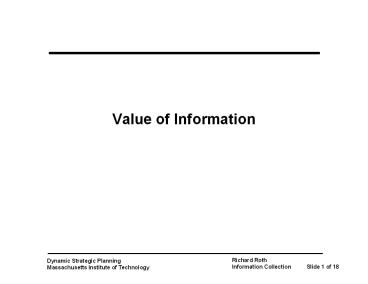Value of Information PowerPoint PPT Presentation
1 / 18
Title: Value of Information
1
Value of Information
2
Information Collection - Key Strategy
- Motivation
- To reduce uncertainty which makes us choose
second best solutions as insurance - Concept
- Insert an information-gathering stage (e.g., a
test) before decision problems, as an option
DecisionProblem
D
Test
DecisionProblem
3
Operation of Test
- EV (after test) gt EV (without test)
- Why?
- Because we can avoid bad choices and take
advantage of good ones, in light of test results - Question
- Since test generally has a cost, is the test
worthwhile?What is the value of
information?Does it exceed the cost of the test?
4
Value of Information - Essential Concept
- Value of information is an expected value
- Expected value after test k
- ??pk(Dk)
- Pk probablility, after test k, of an
observation which will lead to an optimal
decision (incorporating revised probabilities due
to observation) Dk - Expected Value of information EV (after test)
- EV (without test) ??pk(Dk) - ??pk(Ej)Oij
k
k
k
5
Expected Value of Perfect Information - EVPI
- Perfect information is a hypothetical concept
- Use Establishes an upper bound on value of any
test - Concept Imagine a perfect test which
indicated exactly which Event, Ej, will occur - By definition, this is the best possible
information - Therefore, the best possible decisions can be
made - Therefore, the EV gain over the no test EV must
be the maximum possible - an upper limit on the
value of any test!
6
(No Transcript)
7
EVPI Example
- Question Should I wear a raincoat? RC -
Raincoat RC - No Raincoat - Two possible Uncertain Outcomes (p 0.4) or
No Rain (p 0.6)
- Remember that better choice is to take raincoat,
EV 0.8
8
EVPI Example (continued)
EV (after test) 0.4(5) 0.6(4)
4.4 EVPI 4.4 - 0.8 3.6
9
Application of EVPI
- A major advantage EVPI is simple to calculate
- Notice
- Prior probability of the occurrence of the
uncertain event must be equal to the probability
of observing the associated perfect test result - As a perfect test, the posterior probabilities
of the uncertain events are either 1 ot 0 - Optimal choice generally obvious, once we know
what will happen - Therefore, EVPI can generally be written directly
- No need to use Bayes Theorem
10
Expected Value of Sample Information - EVSI
- Sample information are results taken from an
actual test 0 lt EVSI lt EVPI - Calculations required
- Obtain probabilities of test results, pk
- Revise prior probabilities pj for each test
result TRk gt pjk - Calculate best decision Dk for each test result
TRk (a k-fold repetition of the original decsion
problem) - Calculate EV (after test) ??pk(Dk)
- Calculate EVSI as the difference between EV
(after test) - EV (without test) - A BIG JOB
k
11
(No Transcript)
12
EVSI Example
- Test consists of listening to forecasts
- Two possible test results
- Rain predicted RP
- Rain not predicted NRP
- Assume the probability of a correct forecast
0.7 - p(RP/R) P(NRP/NR) 0.7
- P(NRP/R) P(RP/NR) 0.3
- First calculation probabilities of test results
- P(RP) p(RP/R) p(R) P(RP/NR) p(NR) (0.7)
(0.4) (0.3) (0.6) 0.46 - P(NRP) 1.00 - 0.46 0.54
13
EVSI Example (continued 2 of 5)
- Next Posterior Probabilities
- P(R/RP) p(R) (p(RP/R)/p(RP)) 0.4(0.7/0.46)
0.61P(NR/NRP) 0.6(0.7/0.54) 0.78Therefore,
p(NR/RP) 0.39 p(R/RNP) 0.22
14
EVSI Example (continued 3 of 5)
- Best decisions conditional upon test results
EV (RC) (0.61) (5) (0.39) (-2) 2.27 EV
(RC) (0.61) (-10) (0.39) (4) -4.54
15
EVSI Example (continued 4 of 5)
- Best decisions conditional upon test results
EV (RC) (0.22) (5) (0.78) (-2) -0.48 EV
(RC) (0.22) (-10) (0.78) (4) 0.92
16
EVSI Example (continued 5 of 5)
- EV (after test) p(rain pred) (EV(strategy/RP))
P(no rain pred) (EV(strategy/NRP)) 0.46
(2.27) 0.54 (0.92) 1.54 - EVSI 1.54 - 0.8 0.74 lt EVPI
17
Practical Example - Is a Test Worthwhile?
- If value is Linear (i.e., probabilistic
expectations correctly represent valuation of
outcomes under uncertainty) - Calculate EVPI
- If EVPI lt cost of test Reject test
- Pragmatic rule of thumbIf cost gt 50
EVPI Reject test(Real test are not close to
perfect) - Calculate EVSI
- EVSI lt cost of test Reject test
- Otherwise, accept test
18
Is Test Worthwhile? (continued)
- If Value Non-Linear (i.e., probabilistic
expectation of value of outcomes does NOT reflect
attitudes about uncertainty) - Theoretically, cost of test should be deducted
from EACH outcome that follows a test - If cost of test is knownA) Deduct costsB)
Calculate EVPI and EVSI (cost deducted)C)
Proceed as for linear EXCEPT Question is if
EVPI(cd) or EVSI(cd) gt 0? - If cost of test is not known A) Iterative,
approximate pragmatic approach must be
usedB) Focus first on EVPI C) Use this to
estimate maximum cost of a test

